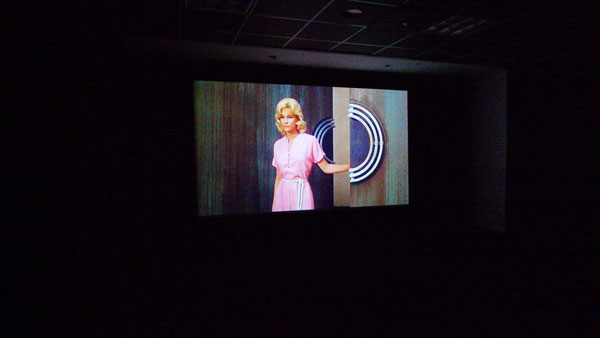Wake Me Up When It’s Over is a compelling and timely installation featuring selected works from 1998–2016 by the London-based duo Thomson & Craighead. Jon Thomson and Allison Craighead, who have been working together since the mid 1990s, utilize data, information and images drawn from internet sources like Flickr, or RSS feeds as raw material to create artworks of aesthetic, social and political merit that explore the myriad ways that technology has changed how we understand the world around us.
In doing so, Thomson & Craighead monitor the way information is visually, aurally and textually communicated. Their intellectually and aesthetically rigorous works address the ills of a networked society and the ensuing fears and paranoia associated with an increased dependency on technology. The effect of this work is cumulative, and the 18-year trajectory presented at Young Projects reinforces the power of their message.

Thompson & Craighead, Installation view: a still from “The Time Machine in Alphabetical Order,” 2010, ©Thompson & Craighead, courtesy of the artists and Young Projects Gallery, Los Angeles.
Instead of exploiting the sensationalism of their source material, Thomson & Craighead appropriate thoughtfully, reinterpreting and re-presenting givens so that they can be seen and understood in a new context. For example, in Trooper (1998), they repeat and speed up a CNN clip of a woman being dragged from her car at gunpoint by a policeman. They effectively reduce the factual content into an unintelligible high pitched clip. At once hilarious and unsettling, Trooper addresses growing fears of violence inflicted on innocents by American police.
The re-sequencing of information is a recurring methodology, which they often use to deconstruct narratives. The content is typically reformatted via an algorithm that produces fictitious yet simultaneously believable results. To create The Time Machine in Alphabetical Order (2010), Thomson & Craighead re-edited the 1960 film adaptation of H.G. Wells’ novella Time Machine so that the dialogue was presented in alphabetical and chronological order, thus transforming the narrative into gibberish. Yet, as in Christian Marclay’s The Clock (2010), the new sequence is not without meaning. It follows a logical pattern (the alphabet) that is related to the sequential passage of time.
Thomson & Craighead also use their impressive technical prowess to write computer algorithms that produce generative works drawn from various online sources. In The First Person (2014), they juxtapose statements from self-help websites with a video depicting a burning house. This coupling, which challenges conventions, inflicts a state of perpetual anxiety undermining the supposedly helpful suggestions for self- improvement in the found texts.
Through video projections and sound installations in which the viewer sees and hears fragments of the original source material, Thomson & Craighead manipulate representations, isolating these fragments from their source and binding them to new contexts. However, their work is not only digital. What could be more powerful than Apocalypse (2016), a fragrance that attempts to capture the stench of the “end of time” using ingredients as described in The Book of Revelation? This survey of Thomson & Craighead affirms the duo’s investment in understanding and making sense of the infinite flow of information that is a given in contemporary society, and they mine this data in a variety of ways, turning it into visually dynamic and content-rich artworks.


